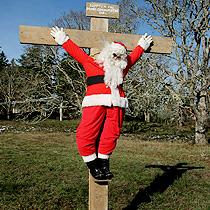

The Curious Case Of Santa Claus In Japan: A Unique Holiday Tradition
Have you ever heard the story of a Japanese department store that displayed Santa Claus nailed to a cross? This peculiar tale highlights the fascinating intersection of culture, commercialization, and the blending of Western and Eastern holiday traditions. After World War II, Japan began to embrace and adapt various Western holiday celebrations, leading to some unusual and sometimes humorous interpretations. Understanding how these traditions evolved reveals much about Japan's relationship with the West, particularly during periods of significant cultural exchange.
Driven by a robust retail industry and a cultural penchant for gift-giving, Japan adopted and adapted many Western holidays. However, these celebrations often took on unique forms that may seem bizarre to outsiders. From Valentine's Day to Christmas, Japan's interpretations have shown a blend of reverence and irreverence, creating a fascinating cultural tapestry.
Christmas, in particular, has become a highly commercialized and secular holiday in Japan, with less than 2% of the population identifying as Christian. This transformation has led to the adoption of many Western traditions, but with a distinct Japanese twist. The story of Santa Claus being displayed in a department store offers a humorous reflection of this cultural blending, characterized by both creativity and a lack of understanding of the holiday's deeper meanings.
What You Will Learn
- The evolution of Christmas celebrations in Japan post-World War II.
- Examples of Western holiday traditions adapted in Japan.
- The humorous and often bizarre blending of cultures.
- Insights into the commercialization of Christmas in Japan.
Japan's adoption of Western holidays has led to a variety of unique practices, often stripped of their original meanings. For instance, Valentine's Day in Japan is celebrated as a day for women to give chocolates to men, which has in turn led to the creation of "White Day," where men reciprocate a month later. Such practices illustrate how deeply retail influences cultural celebrations, often reshaping them into something entirely new.
In the case of Christmas, many traditional elements have been integrated into Japanese celebrations, including Christmas lights, trees, and even the popular practice of exchanging "kurisumasu" cakes. However, the essence of the holiday as a religious observance is largely absent, showcasing Japan's unique approach to what is considered a Western holiday. The blending of Christmas with local customs often results in quirky adaptations, such as KFC marketing itself as a traditional Christmas meal in Japan!
As you can see, the story of Santa Claus nailed to a cross is not just a humorous anecdote, but a reflection of a deeper cultural phenomenon. It symbolizes the complexities of cultural exchange, where both reverence and commercialization coexist, leading to a fascinating and sometimes bewildering holiday experience. Understanding these traditions allows us to appreciate the rich tapestry of cultural influences that shape our celebrations today.

The blending of cultures creates a unique perspective on traditional holidays, illustrating that even something as iconic as Santa Claus can be interpreted in unexpected ways. The story of the crucified Santa is a comedic reminder of how cultural misunderstandings can lead to striking imagery and narratives that resonate across different societies. In the spirit of the holiday season, it challenges us to think about the meanings we assign to our holiday traditions and how they may evolve over time.
Fabio's Goose Encounter: The Truth Behind The Roller Coaster Incident
Examining The Misleading Rumors Surrounding Wendy's Restaurant Closures
Understanding The Truth Behind Benadryl And Xylitol: What Pet Owners Need To Know
